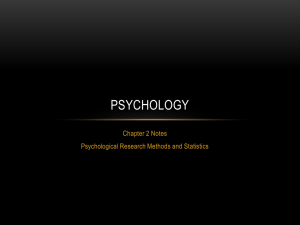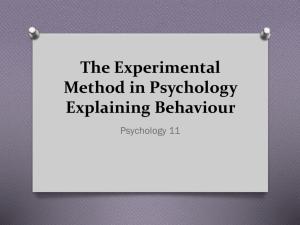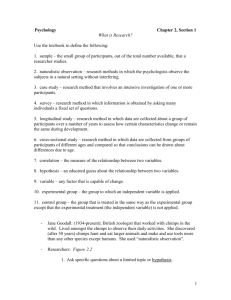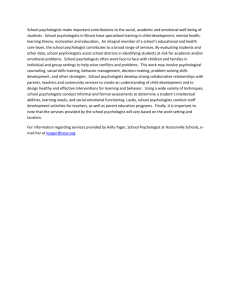Chapter 2 - Cherokee County Schools
advertisement
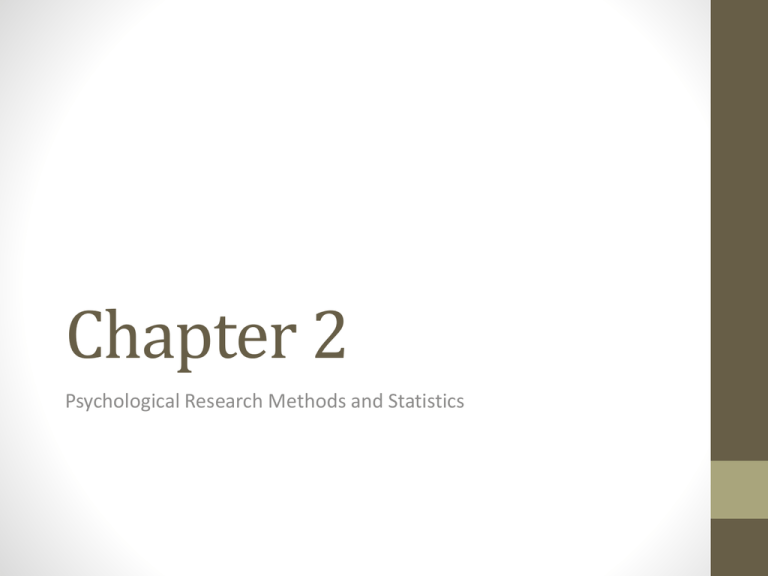
Chapter 2 Psychological Research Methods and Statistics Introduction • Jane Goodall observed the behavior of chimpanzees in Tanzania, Africa, to obtain data • She observed the behavior of chimps over a period of 30 years and provided much information about the animals’ lives • Whereas Goodall used the research methods of naturalistic observation and case study, other psychologists use methods such as conducting experiments and surveys. Introduction (cont…) • Psychologists collect information somewhat like most people do in everyday life – only more carefully and more systematically. • When you turn on the television and the picture is out of focus, you experiment with different knobs and dials until you find one that works. • When you ask a number of friends about a movie you are thinking of seeing, you are conducting an informal survey. Introduction (cont…) • Of course, there is more to doing scientific research than turning dials or asking friends what they think. • Over the years psychologists, like other scientists, have transformed these everyday techniques for gathering and analyzing information into more precise tools. Pre-Research Decisions • Researchers must begin by asking a specific question about a limited topic or hypothesis. • The next step is to look for evidence. • The method a researcher uses to collect information partly depends on the research topic. • Whatever approach to gathering data a psychologist selects, certain basic decisions must be made in advance. Samples • Suppose a psychologist wants to know how the desire to get into college affects the attitudes of high school juniors and seniors. • Instead of studying every junior and senior in the country, the researcher would select a sample, a relatively small group out of the total population under study. • Sample: the small group of participants, out of the total number available, that a researcher studies Samples (cont…) • A sample must be representative of the population a researcher is studying; there are two ways to avoid a nonrepresentative sample. • One is to take a purely random sample so that each individual has an equal chance of being represented. • The second way is to pick deliberately individuals who represent the various subgroups in the population being studied; this is called a stratified sample. Methods of Research • The goals of research are to describe behavior, to explain its causes, to predict the circumstances under which certain behaviors may occur again, and to control certain behaviors. • Psychologists use various methods of research to accomplish each of these goals. Naturalistic Observation • Researchers need to know how people and animals behave naturally, when they are not conscious of being observed during an experiment. • To obtain such information, a psychologist uses naturalistic observation, where the observation is as unobtrusive as possible. • Naturalistic observation: research method in which the psychologist observes the subject in a natural setting without interfering. Case Studies • A case study is an intensive study of a person or group. • Case study: research method that involves an intensive investigation of one or more participants • Most case studies combine long-term observations with diaries, tests, and interviews. • By itself, however, a case study does not prove or disprove anything. Surveys • The most practical way to gather data on the attitudes, beliefs, and experiences of large numbers of people is through surveys. • Survey: research method in which information is obtained by asking many individuals a fixed set of questions • A survey may consist of interviews, questionnaires, or a combination of the two; there are benefits and problems with each method. Longitudinal Studies • In longitudinal studies, a psychologist studies the same group of people at regular intervals over a period of years to determine whether their behavior and/or feelings have changed and if so, how. • Longitudinal Studies: research method in which data is collected about a group of participants over a number of years to assess how certain characteristics change or remain the same during development. • These studies are time-consuming and precarious; however, they are an ideal way to examine consistencies and inconsistencies in behavior over time. Cross-Sectional Studies • An alternative approach to gathering data is cross-sectional studies. • Cross-Sectional study: research method in which data is collected from groups of participants of different ages and compared so that conclusions can be drawn about differences due to age. • In this study, psychologists organize individuals into groups based on age. • Then, these groups are randomly sampled, and the members of each group are surveyed, tested, or observed simultaneously. Correlations and Explanations • A researcher may simply want to observe people or animals and record these observations in a descriptive study. • More often, however, researchers want to examine the relationship between two sets of observations; scientists use the word correlation to describe how two sets of data relate to one another. • Correlation: the measure of a relationship between two variables or sets of data A Correlational Study Experiments • Experimentation enables the investigator to control the situation and to decrease the possibility that unnoticed, outside variables will influence the results. • Every experiment has a hypothesis, or an educated guess, about the expected outcome – the researcher has some evidence for suspecting a specific answer. • Hypothesis: an educated guess about the relationship between two variables Experiments (cont…) • In designing and reporting experiments, psychologists think in terms of variables, conditions and behaviors that are subject to change. • Variable: any factor that is capable of change • There are two types of variables: • independent • Dependent • Independent variable is the one experimenters change or alter so they can observe its effects. • If an effect is found, the dependent variable is the one that changes in relation to the independent variable. • For example, the number of hours you study (the independent variable) affects your performance on an exam (the dependent variable) Experiments (cont…) • Participants who are exposed to the independent variable are in the experimental group. • Experimental group: the group to which and independent variable is applied • Participants who are treated the same way as the experimental group, except that they are not exposed to the independent variable, make up the control group. • Control group: the group that is treated in the same way as the experimental group except that the experimental treatment is not applied • A control group is necessary in all experiments. • Without it, a researcher cannot be sure the experimental group is reacting to what she/he thinks it is reacting to – a change in the independent variable. Experimental Research Experiments (cont…) • By comparing the way control and experimental groups behaved in an experiment (statistically), the researchers can determine whether the independent variable influences behavior and how it does so. • However, psychologists do not fully accept the results of their own or other people’s studies until the results have been replicated – that is, duplicated by at least one other psychologist with different participants. Ethical Issues • Ethics are the methods of conduct, or standards, for proper and responsible behavior. • The American Psychological Association (APA) published a set of ethical principles that govern psychologist’ research. APA Ethical Principles • Using recognized standards of competence and ethics, psychologists plan research so as to minimize the possibility of misleading results. Any problems are resolved before research is started. The welfare and confidentiality of all participants are to be protected. • Psychologists are responsible for the dignity and welfare of participants. Psychologists are also responsible for all research the perform or is performed by others under their supervision. • Psychologists obey all state and federal laws and regulations as well as professional standards governing research. • Except for anonymous surveys, naturalistic observations, and similar research, psychologists reach an agreement regarding the rights and responsibilities of both participants and researcher(s) before research is started. APA Ethical Principles cont… • When consent is required, psychologists obtain a signed, informed consent before starting any research with participant. • Deception is only used if no better alternative is available. Under no condition is there deception about (negative) aspects that might influence a participant’s willingness to participate. • Other issues covered include sharing and utilizing data, offering inducements, minimizing evasiveness, and providing participants with information about the study. • Recently the use of animals in research has caused much concern and debate. Researchers have attempted to balance the rights of animals with the need for advancing the health of humans through research. While some people oppose subjecting animals to pain for research purposes, other point to the enormous gains in knowledge and reduction in human suffering that have resulted from such research. Section 2 Was She Doomed? One young woman died of fear in a most peculiar way: When she was born, on Friday the 13th, the midwife who delivered her and two other babies that day announced that all 3 were hexed and would die before their 23rd birthday. The other 2 did die young. As the 3rd woman approached her 23rd birthday she checked into a hospital and informed the staff of her fears. The staff noted that she dealt with her anxiety by extreme hyperventilation. Shortly before her birthday, she hyper ventilated to death. Introduction • Once an exception is set, we tend to act in ways that are consistent with that expectation. • A self-fulfilling prophecy involves having expectations about a behavior and then acting in some way, usually unknowingly, to carry out that behavior. • Self-fulfilling prophecy: a situation in which a researcher’s expectations influence that person’s own behavior, and thereby influence the participant’s behavior Avoiding a Self-Fulfilling Prophecy • Sometimes an experimenter’s behavior may unwittingly influence the results. • One way to avoid this self-fulfilling prophecy is to use the single-blind or double-blind technique. • To study the effects of a particular tranquilizer, a psychologist might give the drug to an experimental group and a placebo (a substitute for the drug that has no medical benefits) to a control group. Avoiding Self-Fulfilling Prophecy (cont…) • The next step would be to compare their performances on a series of tests. • This is a single-blind experiment. • Single-blind experiment: an experiment in which the participants are unaware of which participants received the treatment • The participants are “blind” in the sense that they do not know whether they have received the tranquilizer or the placebo. Avoiding Self-Fulfilling Prophecy (cont…) • The researcher also may not now who takes the drug or the placebo. • After she scores the tests, she goes back to the pharmacist to learn which participants took the tranquilizer and which took the placebo. • This is a double-blind experiment. • Double-blind experiment: an experiment in which neither the experimenter nor the participants know which participants received which treatment Single and Double Blind Experiments The Milgram Experiment • In the 1960s Stanley Milgram wanted to determine whether participants would administer painful shocks to others merely because an authority figure instructed them to do so. • The volunteers did not realize the shocks were false because the learners displayed distress and pain, screaming and begging for the electric shocks to stop. • Although the task did not seem easy, most of the volunteers delivered a full range of the electric shocks. The Milgram Experiment (cont…) • The results implied that ordinary individuals could easily inflict pain on others if such orders were issued by a respected authority. • Later, Milgram informed the volunteers that they had been deceived and that no shocks had actually been administered. • This was good example of a single-blind experiment because the participants were unaware that they were not administering a shock. The Milgram Experiment (cont…) • Critics raised the following questions: • How would you feel if you had been one of Milgram’s partcipants? • Did Milgram violate ethical principles when he placed participants in a position to exhibit harmful behavior? • Was the deception Migram used appropriate? • Before the start of any experiment today, the experimenter is required to submit a plan to a Human Subjects Committee that can either approve or reject the ethics of the experiment. The Placebo Effect • When researchers evaluate the effects of drugs, they must always take into account a possible placebo effect. • The placebo effect is a change in a patient’s illness or physical state that results solely from the patient’s knowledge and perceptions of the treatment. • Placebo effect – a change in a participant’s illness or behavior that results from a belief that the treatment will have an effect, rather than the actual treatment The Placebo Effect (cont…) • The placebo is some sort of treatment such as a drug or injection, that resembles medical therapy yet has no medical effects. • In one study, researchers divided hospitalized psychiatric patients into 2 experimental groups and a control group. They gave the experimental groups either a “new tranquilizer” or a “new energizer” drug. The control group received no drugs at all. After a 6 week period, the researchers evaluated the experimental groups. • 53 to 80% of the experimental groups reported that they indeed benefited from the drugs. Yet all the drugs administered during the experiment were placebos. The participants had reacted to their own expectations of how the drug given to them would affect them. • Neither the researchers nor the patients were aware that the drugs were placebos until after the experiment. Section 3 Long ago, when Johns Hopkins University had just begun to admit women students, someone not particularly enamored of coeducation reported a real shocker: one-third of women at Hopkins (33%) had married faculty members! The raw figures gave a clearer picture… there were 3 women enrolled at that time, an done of them had married a faculty member. Introduction • Although people may use statistics to distort the truth, people may also use statistics honestly to support their hypotheses. • In order to allow statistics to validly support a hypothesis, psychologists must collect meaningful data and evaluate it correctly. Introduction (cont…) • How many times have you been told that in order to get good grades, you have to study? • A psychology student named Kate has always restricted the amount of TV she watches during the week, particularly a test. • She has a fiend, though, who does not watch TV before a test but who still does not get good grades. • This fact challenges Kate’s belief. Introduction (cont…) • Although Kate hypothesizes that among her classmates, those who watch less TV get better grades, she decides to conduct a survey to test the accuracy of her hypothesis. • Kate asks 15 students in her class to write down how many hours of TV they watched the night after the quiz. Introduction (cont…) • Kate collects additional data. • She ahs her participants check off familiar products on a list of 20 brand-name items that were advertised on TV the night before the quiz. • Kate also asks her participants to give their height. • When the data are turned in, Kate finds herself overwhelmed with the amount of information she has collected. Introduction (cont…) • How can she organize it all so that it makes sense? • How can she analyze it to see whether it supports or contradicts her hypothesis? • The answers to these questions are found in statistics, a branch of mathematics that enables researchers to organize and evaluate the data they collect. • Statistics – the branch of mathematics concerned with summarizing and making meaningful inferences from collections of data Descriptive Statistics • When a study such as Kate’s is completed, the first task is to organize the data in a brief, clear, and logical format. • Descriptive statistics is the listing and summarizing of data in a practical, efficient way, such as through graphs and averages. • Descriptive statistics: the listing and summarizing of data in a practical, efficient way Distributions of Data • One of the first steps that researchers take to organize their data is to create frequency tables and graphs. • Tables and graphs provide a rough picture of the data. • Are the scores bunched up or spread out? What score occurs most often? • Frequency distributions and graphs provide researchers with their initial “peek” at the data. Distributions of Data (cont…) • Kate is interested in how many hours of TV her participants watch the night before and the night after the quiz. • She uses the numbers of hours of TV viewing as categories, and then she counts how many participants reported each category of hours before and after the quiz. • Kate has created a table called a frequency distribution. Distribution of Data (cont…) • A frequency distribution is a way of arranging data so that we know how often a particular score or observation occurs. • Frequency distribution: an arrangement of data that indicates how often a particular score or observation occurs • With her information, Kate could figure out percentages. Distributions of Data (cont…) • It is often easier to visualize frequency information in the form of a graph. • Histograms show frequency distribution by means of rectangles whose widths represent class intervals and whose areas are proportionate to the corresponding frequencies. • Another kind of graph is the frequency polygon or frequency curve. Distributions of Data (cont…) • Imagine that Kate could measure how much TV everyone in Chicago watched one night. • A few people would watch little or not TV, a few would have the TV on all day, while most would watch a moderate amount of TV. • Therefore, the graph would be highest in the middle and taper off toward the tails, or ends, of the distribution, giving it the shape of a bell. Distributions of Data Distributions of Data (cont…) • This curves is called the normal curve (or bell-shaped curve). • Normal curve: a graph of frequency distribution shaped like a symmetrical, bell-shaped curve; a graph of normal distribution • Many variables, such as height, weight, and IQ, fall into such a curve if enough people are measured. • The normal curve is symmetrical. Measures of Central Tendency • Most of the time, researchers want to do more than organize their data; they want to be able to summarize information about the distribution into statistics. • One of the most common ways of summarizing is to use a measure of central tendency – a number that describes something about the “average” score of a distribution Measures of Central Tendency (cont…) • The mode is the most frequent score; in a graphed frequency distribution, the mode is the peak of the graph. • When scores are put in order from least to most, the median is the middle score; since the median is the midpoint of a set of values, it divides the frequency distribution into two halves. • The mean is what most people think of as an “average” and is the most commonly used measure of central tendency. A Frequency Polygon Measures of Variance • Distributions differ in terms of how “spread out” or how variable the scores are. • Measures of variance provide an index of how spread out the scores of a distribution are. • Variance: a measure of difference, or variance • Two commonly used measures of variance are the range and the standard deviation. Measures of Variance • The range uses only a small amount of information, and it is used only as a crude measure of variance. • The standard deviation is a better measure of variance because, like the mean, it uses all the data points in its calculation. • Standard deviation: a measure of variability that describes an average distance of every score from the mean Standard Deviation Correlation Coefficients • A correlation coefficient describes the direction and strength of the relationship between two sets of observations. • Correlation coefficient: describes the direction and strength of the relationship between two sets of variables • Coefficients can have positive and negative correlations. • A scatterplot is a graph of participants’ scores on the two variables. Inferential Statistics • Psychologists also want to make generalizations about the population from which the participants come. • Using inferential statistics, researcher can determine whether the data they collect support their hypotheses, or whether their results are merely due to chance outcomes. • Inferential statistics: numerical methods used to determine whether research data support a hypothesis or whether results were due to chance A Scatterplot Probability and Chance • When a researcher complete an experiment, he or she is left with lots of data to analyze. • The researcher must determine whether the findings from the experiment support the hypothesis or whether the results are due to chance. • To do this, the researcher must perform a variety of statistical tests, called measures of statistical significance. Statistical Significance • For many traits in a large population, the frequency distribution follows a characteristic pattern, called the normal curve. • When psychologists evaluate the results of their studies, they ask: Could the results be due to chance? • What researchers really want to know is whether the results are so extreme – or so far away from the normal curve – that they are more likely due to chance. Statistical Significance (cont…) • The problem is that this question cannot be answered with a yes or no. • This is why researcher use some guidelines to evaluate probabilities. • When the probability of a result is whatever level the researcher sets, we say that the result is statistically significant. • It is important to remember that probability tells us how likely it is that an event or outcome is due to chance, but not whether the event is actually due to chance.

